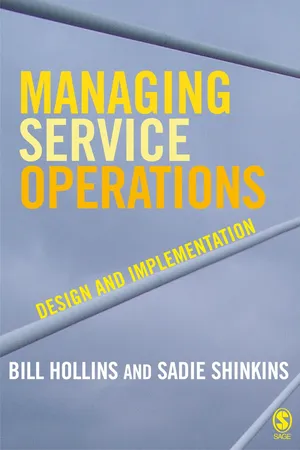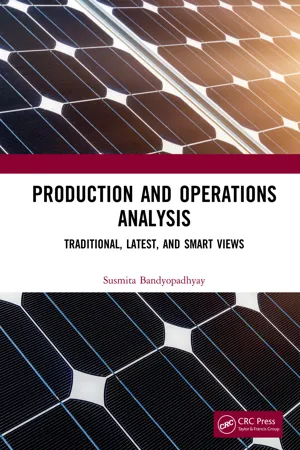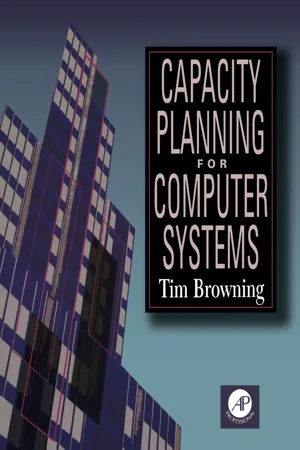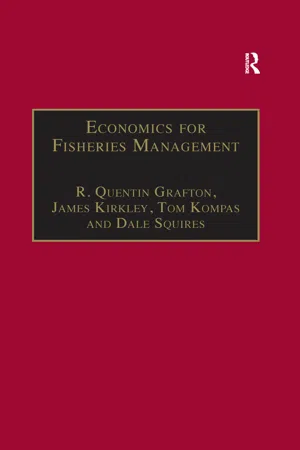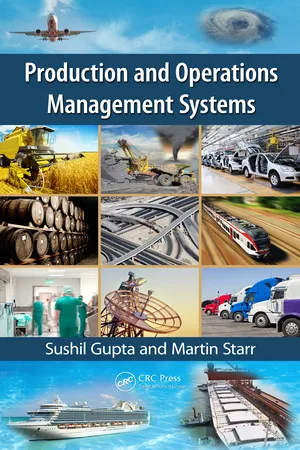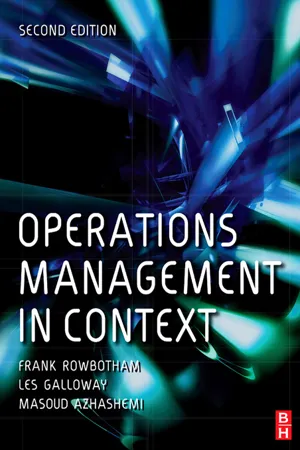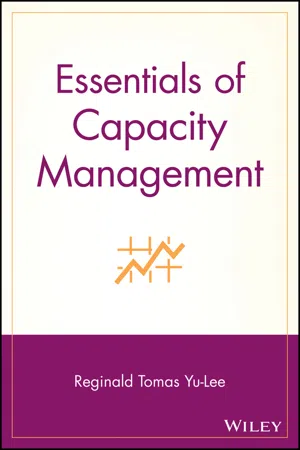Business
Capacity
Capacity in business refers to the maximum level of output a company can produce, or the resources it can effectively utilize. It encompasses both physical and human resources, and is crucial for determining a company's ability to meet demand and grow. Understanding and optimizing capacity is essential for efficient operations and strategic planning.
Written by Perlego with AI-assistance
Related key terms
1 of 5
12 Key excerpts on "Capacity"
- eBook - PDF
Managing Service Operations
Design and Implementation
- Bill Hollins, Sadie Shinkins(Authors)
- 2006(Publication Date)
- SAGE Publications Ltd(Publisher)
Hence, Capacity can be described as the ‘throughput’, or number of units a facility can hold, receive, store, or produce in a period of time. For example, a car park may only be fully occupied during the working day when it is used by office workers. Slack et al. (2004) define Capacity as the maximum level of value added activity achievable over a period of time under normal operating conditions. Capacity can be expressed in terms of inputs or outputs, as in a retail store that has an input measure of sales floor area and an output of number of items sold per day; a brewery counts the volume of its tanks as an input measure, the output is then the number of litres brewed per week (see Table 12.1). The output and Capacity have to be in the same terms, e.g. units or customers etc. Product-focused firms talk about outputs, e.g. barrels of beer per year, car plants about 1,500 cars per day Capacity. A service like a restaurant might consider how many sit-down and how many take-away customers it can cater for, then it can plan for the best combination. How do we measure demand? The first stage of Capacity planning will be measuring demand. For operations man-agers this means having to deal with forecasts of demand which may well be inac-curate. In many organizations it is the sales or marketing department which is responsible for demand forecasting. However, since such forecasts form an essential ingredient in Capacity planning the operations manager needs to understand the basis of such demand forecasts. Forecasts need to be expressed in terms that can be used for Capacity planning and control rather than only expressed in monetary terms.The aim is a forecast that gives some idea of the demands to be placed on the operation’s Capacity. - eBook - ePub
Production and Operations Analysis
Traditional, Latest, and Smart Views
- Susmita Bandyopadhyay(Author)
- 2019(Publication Date)
- CRC Press(Publisher)
11Capacity Planning
11.1 Introduction
Capacity can be defined as the ability to hold, receive, and store raw materials or finished goods or any other resource. Capacity is a set of resources that can be utilized to generate value for the customers. Examples of Capacity include space, equipments, human resources, and so on. Capacity is generally purchased or owned in large quantity. Capacity is multidimensional in nature. The general dimensions are:• Type: This indicates the type of manufacturing systems on which the type of analysis depends. Such “type” includes, for example, automated or manual, standard manufacturing or advanced manufacturing, capital intensive or not, and so on.• Amount: This indicates the amount purchased or hired or owned Capacity required. This can be expressed in terms of time periods or number of pieces per period.• Cost: This indicates the total cost to be incurred for acquiring, running, maintaining, a manufacturing system.Capacity must be used wisely. If the available Capacity is greater than that used, then the excess Capacity represents wastage. On the contrary, if the available Capacity is less than that used, then there is a shortage of Capacity and the amount of shortage is known as demand surplus. This chapter will emphasize on manufacturing Capacity only. The characteristics of manufacturing Capacity are:• The Capacity can be changed if required at the discrete point of time.• Significant lead time is required in order to change Capacity.• In general, Capacity cannot be decreased but rather it can be increased.Capacity can be design Capacity which is the maximum output rate that is possible under ideal condition whereas the effective Capacity is the maximum output rate that is possible under normal condition. On the basis of design Capacity and effective Capacity, the utilization can also be designed or can be made effective and is given by expressions (11.1) and (11.2) . However, the usual expression for utilization is provided in expression (11.3) - eBook - PDF
Back to Basics
Your Guide to Manufacturing Excellence
- Steven A. Melnyk, R. T. Chris Christensen(Authors)
- 2000(Publication Date)
- CRC Press(Publisher)
At the strategic level, Capacity is capability or what the shop or work center can and cannot do. At the tactical level (which is the focus of this section), Capacity can be defined as being the level of output per unit of time. This definition identifies several important traits of Capacity. First, Capacity is always measured in terms of time. For example, suppose we tell you that there are two work centers each producing 5000 units. This information is either meaningless or potentially confusing. Why? What if the first work center could produce 5000 units in 24 hours, while the second required 120 hours to produce this same number. Now we see that the work centers are different, even though they produce the same number of units. Time is also important when discussing Capacity because Capacity is finite with respect to time and cannot be stored. This last fact is something that is very familiar to every restaurant, bank, or similar service operation. When seats in a restaurant are available and empty at 10:00 in the morning, that unused Capacity cannot be stored until it would be needed for peak traffic. Capacity that is not used during a period of time is gone. We can look at inventory as being a form of stored Capacity. When we build inventory, we convert the Capacity into product which can then be used to meet demand during peak periods. When dealing with Capacity, we must consider two specific types. The first is Capacity that is based on resources. A work center can consist of a Capacity: You Can’t Build It if You Don’t Have the Capacity 95 machine that is available 24 hours a day, 7 days a week. It can also consist of a worker who operates the equipment. Finally, the work center can also consist of the various tooling that is needed to allow the equipment to process the various orders that pass through it. Each of these components has varying levels of availability. - eBook - PDF
- Tim Browning(Author)
- 2014(Publication Date)
- Academic Press(Publisher)
As businesses become "on-line," the need for high availability, reliability, and time-sensitive operating environments develops. To run out of disk space, CPU, memory, or any other resource unexpectedly, especially when it is critical to the enterprise, is extremely costly. Today's computer systems, whether they be tiny PCs (alone or in a LAN) or mighty supercomputers (again, alone or in a system complex, sysplex, or system network), must not be "too much, too little, too soon, or too late" for the task. There is no standard definition of Capacity even within the context of Capacity planning. Rather, the definitions of Capacity depend on the behav- Chapter 1 · Capacity Planning Foundations 3 ior of interest and the system components being studied. For example, one definition of Capacity may be stated in requests per unit of time, as in jobs per second, transactions per second, millions of instructions per second (MIPS), or bits per second (for network components). Another definition of Capacity may be the maximum number of a certain workload unit (users) that the system can support while meeting a specified performance objective (a certain response time). One may talk of the usable Capacity as compared to the theoretical capaaty (nominal Capacity). Perhaps the two most central ideas of Capacity involve how quickly something can be done (throughput as the rate at which something can be done by the system or network) or how much can be done (the number of users or workload units—the system load). Given this wide spectrum of meanings for the Capacity of a system, it is no surprise that many people may ask, What is Capacity planning? It is frequently unclear to management what kind of questions are best answered by Capacity planning. Questions such as How many tape drives do we need for the next two years or Will our computer disk system support our business plan? are clearly Capacity planning issues. - eBook - PDF
- Jack R. Meredith, Scott M. Shafer(Authors)
- 2014(Publication Date)
- Wiley(Publisher)
Capacity planning decisions are driven by projected demand estimates for the organization’s outputs. (The role of forecasting is discussed in the supplement to this chapter.) Over the long term, Capacity and location are interwoven considerations, as will be described later in the chapter. Following the long-term discussion, we move into a description of efficiently utilizing the available Capacity through sched- ule management and then into a description of short-term Capacity alternatives, but here we are largely past the point of making a location decision. L O N G - T E R M C A P A C I T Y P L A N N I N G Capacity and location decisions are highly strategic because they are very expensive investments and, once made, are not easily changed or reversed. Hence, they must be carefully and thoroughly analyzed beforehand, using all available tools at man- agement’s disposal. Capacity is generally taken to mean the maximum rate at which a transformation system produces outputs or processes inputs, though the rate may be “all at once.” Table 8.1 lists measures of Capacity for a number of production sys- tems. Notice that since Capacity is defined as a rate, measures should be clear about the time dimension. For instance, how meaningful is it to know that a hospital can perform 25 surgeries? Without knowing whether this is simultaneously, per day, per week, or possibly per month, the number is relatively meaningless. As illustrated in Table 8.1, airlines often measure their Capacity in available seat miles (ASMs) per year. One ASM is one seat available for one passenger for 1 mile. Clearly, the number of planes an airline has, their size, how often they are flown, and the route structure of the airline all affect its ASMs, or Capacity. - eBook - ePub
- R. Quentin Grafton, James Kirkley, Dale Squires(Authors)
- 2017(Publication Date)
- Routledge(Publisher)
In other words, Capacity output is defined as the maximum possible output that can be produced given the technology and the input level. Output cannot be expanded beyond YC, because of technological or production constraints. We stress that the measure of Capacity output is purely a technological concept defined by the production frontier and, therefore, is independent of prices and costs. Thus whether it would be economically profitable to produce at Capacity output cannot be resolved without further information. Economic Concept of Capacity An economic, as opposed to technological, measure of Capacity and Capacity utilization is more difficult to define because we have to compare current or observed levels of output to some ‘ideal’, rather than to some maximum level of output. The metric or unit of measurement used by economists for determining the ideal output can vary. It may be defined by costs of production, where the ideal or Capacity output is that which minimizes costs (Morrison 1985), or it might be defined as the level of output that maximizes revenues (Färe et al. 2000a) or profits (Coelli et al. 2000). The most commonly accepted economic concept of Capacity output in the short run corresponds to the output level where short-run average cost and the long-run average cost curves are tangent to each other. This is illustrated in Figure 4.2 where the large U shape curve represents long-run average cost. This long-run curve maps the relationship between the average cost of production and output when all inputs (fixed and variable) can be changed. The long-run curve can be thought of as a ‘lower envelope’ of many smaller short-run average cost curves such that every point on the long-run average cost curve corresponds to a tangency with a short-run average cost curve. For example, points D, B and E represent tangent points for three different short-run cost curves and the long-run curve is constructed from a set of these and other tangent points - eBook - PDF
- Sushil Gupta, Martin Starr(Authors)
- 2014(Publication Date)
- CRC Press(Publisher)
The operating Capacity cannot be more than the designed Capacity. The actual utilization of the four tellers may only be (say) 27 h—based on the number of customers that visit the bank. The same situation applies to grocery stores with one cash register and super-markets with dozens of checkout counters. The number of operating rooms in a hospital is the maximum design Capacity. The number of seats in a restaurant is the maximum design Capacity but the service rate and the length of time that custom-ers stay in their seats determines throughput Capacity. In that regard, maximum operational Capacity can also be defined as maxi-mum sustained throughput of goods or services. Operations Capacity describes how many units can be supplied per unit of time. For services, a bank might compare the maximum number of people the bank teller can process per hour with the maximum number of people the ATM can process per hour. This is a supply chain service Capacity comparison. For a manufacturing supply chain example, compare the maximum number of hot dogs Oscar Meyer (OM) can make and ship per hour with the maximum num-ber of hot dogs Hebrew National (HN) can make and ship per hour. The maxi-mum number is likely to be much bigger than the breakeven number (see Appendix A). In this supply chain the ingredients required to make the products have a flow through rate that must match the producers’ rates. It is not possible to determine if OM is better off than HN without the entire picture of the system. Still, this comparison is one that both companies would like to make to com-pare their PMCs (productivities at maximum Capacity). PMC makes an excellent benchmarking measure. In supply chain terms, benchmarking is a systematic com-parison of fundamental measures with those of contestants performing similar sup-ply chain functions. Many other aspects of Capacity planning are discussed in Chapter 9, Supply Chain Management. - eBook - ePub
High Performance SRE
Automation, error budgeting, RPAs, SLOs, and SLAs with site reliability engineering (English Edition)
- Anchal Arora Mishra(Author)
- 2024(Publication Date)
- BPB Publications(Publisher)
Organizations can prepare for potential increases in demand, avoid resource waste, and ensure optimal system performance by using Capacity planning, which is crucial in SRE. Capacity planning enables SRE teams to forecast growth patterns and anticipate the resources needed to meet expected demand. It enables them to predict the volume of traffic and usage patterns that an application or system will experience, ensuring that the infrastructure is scalable and can handle the expected load. By making sure that resources are used effectively, Capacity planning aids in cost optimization. It helps organizations avoid overprovisioning resources, which can be expensive and wasteful, and under-provisioning resources, which can lead to poor system performance and downtime at a later stage. Capacity planning is crucial in maintaining system reliability. It ensures the system has enough resources to handle the expected load, reducing the chance of system overload, subpar performance, or even crashes. Capacity planning helps organizations to maintain a high level of service reliability and availability.Principles of Capacity managementCapacity planning enables organizations to make the most efficient use of resources. It aids in the identification and elimination of underused resources and makes sure that all resources are used in the best possible way to meet the needs of the system. Capacity planning ensures users have a smooth time using the system or application. It ensures that the system is always available, performs optimally, and can handle sudden surges in demand.Capacity management is based on three basic rules that must be followed for a service to be scalable, usable, and manageable. The rules are as follows:Successful Capacity management requires allocating resources from two complex points of view: resource provisioning, which provides the initial Capacity to run the service now, and Capacity planning, which ensures the reliability of the service in the future.- Services must make good use of the resources they have. Large services that require many resources cost a lot to set up and keep running.
- Services must always work. Limiting resource Capacity to make a service more efficient can cause the service to break down or go down for users. Service efficiency and reliability are not always the same thing.
- Service growth needs to be planned for. Adding resources to a service can take a long time and is limited in how it can be deployed in the real world. This could mean buying and setting up new hardware or data centers. It may also be necessary to increase the Capacity of other software systems and infrastructure the service depends on.
SRE Capacity planning must account for resource requirements. It involves identifying the resources required to support a given workload, such as CPU, memory, storage, network bandwidth, and other hardware and software resources. - eBook - ePub
- Frank Rowbotham, Masoud Azhashemi, Les Galloway(Authors)
- 2012(Publication Date)
- Routledge(Publisher)
Differing planning time horizons. Some of the lead times involved in allocating Capacity can be very long. The building of a brand new operation, for instance, will require a long process of research, planning and execution. It is quite likely that this process will be measured in terms of years. Such Capacity decisions as these therefore have to be made with a long-term perspective. Other decisions are made in a much shorter time frame. Changing working patterns to accommodate sudden staff illness is an example of such a decision. The long- and shorter-term aspects of managing Capacity are both vital to the primary objective of meeting the workload required.4 Scheduling. The act of allocating people to tasks in the short term is called ‘scheduling’. Scheduling is a complex activity, with most situations involving an array of different possible schedules. Some of the basic principles are outlined.How does the operation work?The Capacity of an organization may be defined as its ability to undertake the work demanded by its users. For example, a university might define its overall Capacity in terms of the numbers of students it can teach, an airline by the number of passengers it can carry and an amusement park the number of visitors it can accommodate. These numbers in turn will reflect the individual abilities of the various components which make up the working organization. Broadly, these individual components are the staff, the technology and the facilities. This ability to undertake the work demanded clearly cannot exist without the managers of the organization providing the appropriate resources. It is this task, the task of providing the ability to undertake work, which is the focus of this chapter.More specifically, the chapter looks at how managers can plan and control the operation so that it meets the volume and variety demands of its users. Some of the decisions involved are long term. For example, the planning, building and execution of a new facility such as a new hospital will take many years. However, some decisions are of a much shorter duration. So deciding on the allocation of tasks amongst the nursing staff to meet the running of the maternity unit for the next eight hours is much less involved. The chapter therefore deals with both the macro and the micro aspects of providing the Capacity of the operation. At the macro level, the topics are the importance of forecasting, the relationship between Capacity and anticipated demand, the design of the operations network, the scope of the tasks to be undertaken and the balance of capacities. - eBook - PDF
- Barton A Weitz, Robin Wensley, Barton A Weitz, Robin Wensley(Authors)
- 2002(Publication Date)
- SAGE Publications Ltd(Publisher)
In fact, in many industries, Capacity deci-sions may be the most important aspect of service quality. S ERVICE C APACITY AS A C OMPETITIVE A DVANTAGE Service Capacity and Service Quality Service Capacity as Service Quality We can think of Capacity as a very general term. In many ways, service Capacity is an important measure of our ability to deliver service quality. Capacity represents our capabilities. Greater capa-city implies a greater capability to supply service quality. Considering all the aspects of service qual-ity (Parasuraman et al., 1985), we realize that it is Capacity that allows us to deliver them. Our Capacity strategy, therefore, directly impacts service strategy. For example, we can increase Capacity by expanding the number of servers. As we increase the number of servers, our customers may enjoy shorter waiting times in the service queue or benefit from a higher probability of service. With greater Capacity, we also have the capability of pro-viding each customer with more service. Increasing Capacity, therefore, actually improves the quality of the service output. We expect that Capacity should be directly related to customer satisfaction (Anderson, 1995; Anderson & Fornell, 1999, 2000; Hauser et al., 1994). In many service industries, we can equate supe-rior service to higher Capacity. In retailing, for example, increasing the number of trained floor employees helps customers find assistance more quickly. In medical services, increasing the number of employees can decrease waiting times and allow health-care workers to spend more time with each patient. In the airline industry, increasing the number of flights might allow passengers to choose more convenient flight times. For many home repair services, having more employees increases the probability the home repair provider can make a repair on the same day that the customer calls. We see that customer satisfaction (Anderson et al., 1994, 1997) is directly related to available Capacity. - eBook - PDF
- Reginald Tomas Yu-Lee(Author)
- 2002(Publication Date)
- Wiley(Publisher)
2 2 9 E l e m e n t s o f E f f e c t i v e C a p a c i t y M a n a g e m e n t There are a large number of ways to measure performance, and many are situation specific. This section, therefore, will address key points to help ensure that the measurement system provides the right information from the perspectives of demand, Capacity, operations, and financials. Capacity An organization must know how much Capacity it has and how effectively it is operating. From knowing how much Capacity an organization has, it can determine the cost of the Capacity. By knowing how effectively the Capacity is operating, decisions can be made to determine whether to expand and where expansion should occur. Basic Capacity measures were discussed in Chapters 3 and 6. To reiterate some of the basics, measuring Capacity involves com- bining the basic entities and Capacity measures into operations with certain capabilities. Sometimes the Capacity is known, such as when looking at the operating rate of a machine, and sometimes it is determined through experimentation. Regardless, it is important to always have an understanding of how much Capacity is in the organization. Another criterion to consider is whether and how the Capacity is being utilized. Managers will want to understand the availability of the Capacity to ensure that they are getting what they are paying for. Utilization, too, is important but perhaps not as important as avail- ability. Availability provides flexibility.You may not want the Capacity to operate all of the time, depending on the demand being placed on it (utilization), but you will want to be able to operate the Capacity when it is desirable to do so (availability). Finally, you will want to understand on what the Capacity spends its time. This will help the organization understand the Capacity demands created by certain 2 3 0 E S S E N T I A L S o f C a p a c i t y M a n a g e m e n t - S. Gruneberg, Graham J. Ive(Authors)
- 2000(Publication Date)
- Palgrave Macmillan(Publisher)
The firms in the construction industry mainly merely utilise existing resources, through sometimes making investment decisions which increase Capacity of the industry by, for instance, purchasing new plant and machinery. These plant and machinery investment decisions are more usually taken by plant hire firms, rather than directly by contractors. We find Hillebrandt’s (1984) definition of construction Capacity, as the maximum potential output within acceptable strain, sufficiently flexible to take social factors into account. This is important as Capacity is constantly changing in response to changes in demand. Finally we recognise that Capacity is influenced by international factors such as the international movement of labour and materials. 186 Capacity 8 Capacity of the Firm and the Economics of the Growth of Firms Introduction In the preceding chapter we discussed the meaning of Capacity for industries in general and for construction sector industries in particu- lar. The meaning of excess Capacity in firms in the building materials industry is clear, and refers to under-utilisation of capital intensive plant. Its meaning and existence in construction industry firms is less clear. If it exists, it will be largely a matter of under-utilisation of the firm’s core staff. ‘For the most part, “excess Capacity” is externalised by the contracting firm, appearing as unemployment of construction labour, under utilisation of hire firms’ plant; increased stocks, or reduced output, in the industries producing building inputs; (money) capital held liquid e.g. cash or short term deposits; and a flow of money-capital from construction to other sectors, channelled through both the banks and multi-industry firms’ (Ive, 1983, pp. 72–3) In this chapter we discuss both modified neo-classical and post- Keynesian approaches to cost curves of firms and describe how firms behave in construction markets.
Index pages curate the most relevant extracts from our library of academic textbooks. They’ve been created using an in-house natural language model (NLM), each adding context and meaning to key research topics.
